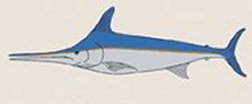Big fish in ancient waters
Fossils have revealed an ancient, oversized relative of modern-day swordfish.
Share this:
- Share via email (Opens in new window) Email
- Click to share on Facebook (Opens in new window) Facebook
- Click to share on X (Opens in new window) X
- Click to share on Pinterest (Opens in new window) Pinterest
- Click to share on Reddit (Opens in new window) Reddit
- Share to Google Classroom (Opens in new window) Google Classroom
- Click to print (Opens in new window) Print
By Emily Sohn
Small things have been in the news a lot lately. First came word of a species of little people who lived in Indonesia tens of thousands of years ago. Then, scientists announced the discovery of an unusually small type of dinosaur that used to live in Germany. This week, it’s news that certain space objects are smaller than astronomers used to think they were.
Make way for something bigger.
 |
|
An artist’s idea of what an ancient billfish, related to modern-day swordfish and marlin, might have looked like.
|
| Courtesy of Harry Fierstine |
A new set of fossils suggests that a species of really big fish lived off the coast of South Carolina 26 million years ago. Now extinct, the giant fish, called Xiphiorhynchus rotundus, belonged to a group of water creatures called billfish. The group includes modern-day swordfish and marlin.
If you could catch an adult X. rotundus today, it would break all world records for size. In modern times, the record holder among billfish is a black marlin that was caught in 1953 off the coast of Peru. It was 4.4 meters (14.4 feet) long and weighed 708 kilograms (1,560 pounds).
X. rotundus was at least 5.1 meters (16.7 feet) long, says Harry Fierstine, a researcher from California Polytechnic State University in San Luis Obispo. That’s about the size of a big alligator!
To come up with this estimate, the scientists compared the X. rotundus fossils with bones from a close European relative (also extinct). The new find included a few vertebrae (spine bones), which measured as much as 14.7 centimeters (5.8 inches) long and 10.9 centimeters (4.3 inches) across.
The ancient fish could have had anywhere from 24 to 26 vertebrae along its spine, so full-grown adults might have been even bigger than an alligator. Either way, X. rotundus is the biggest billfish ever discovered.
Imagine the size of the fishing rod you would need to catch one of those!







